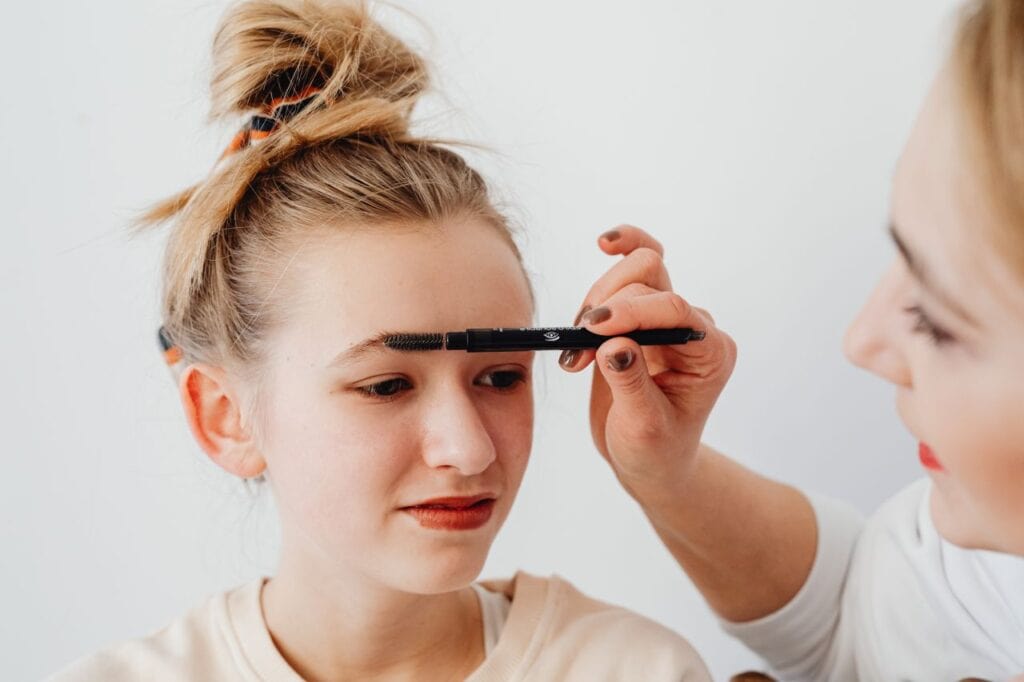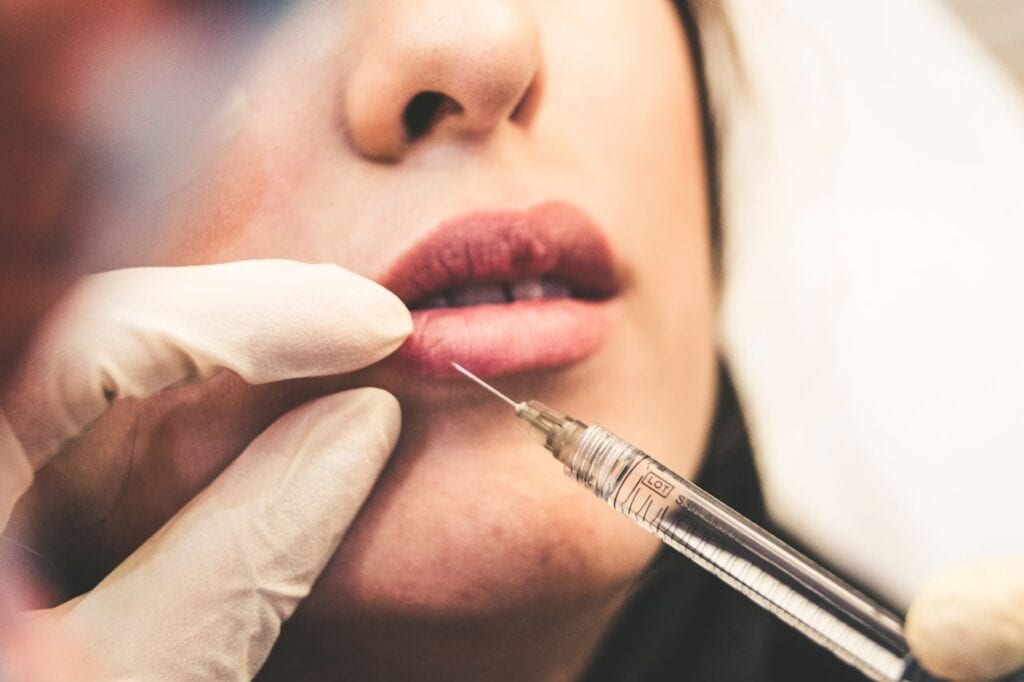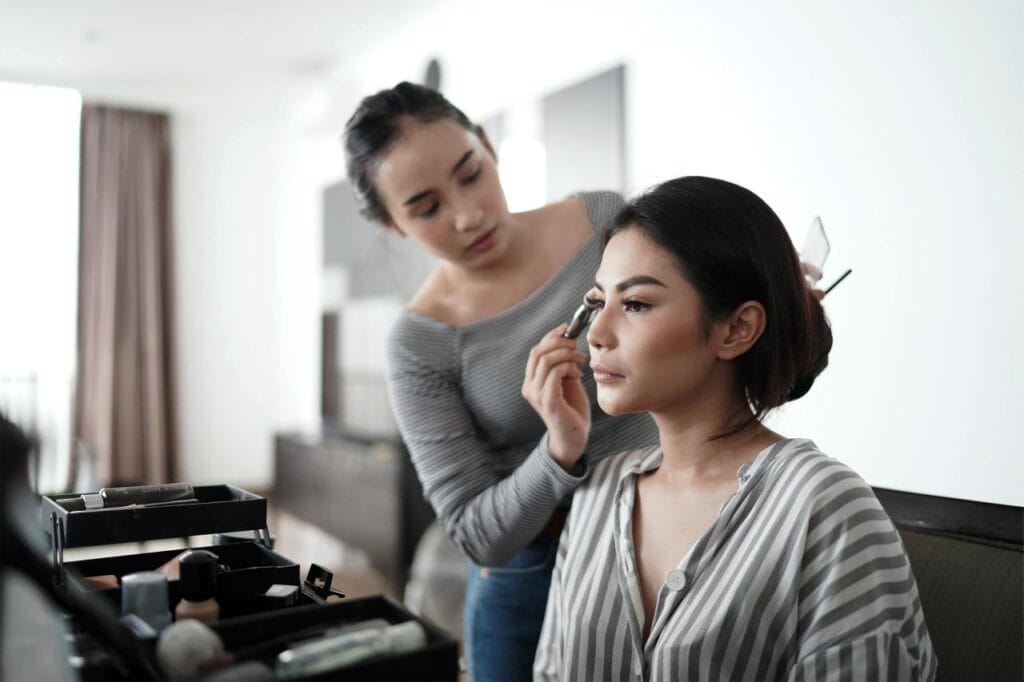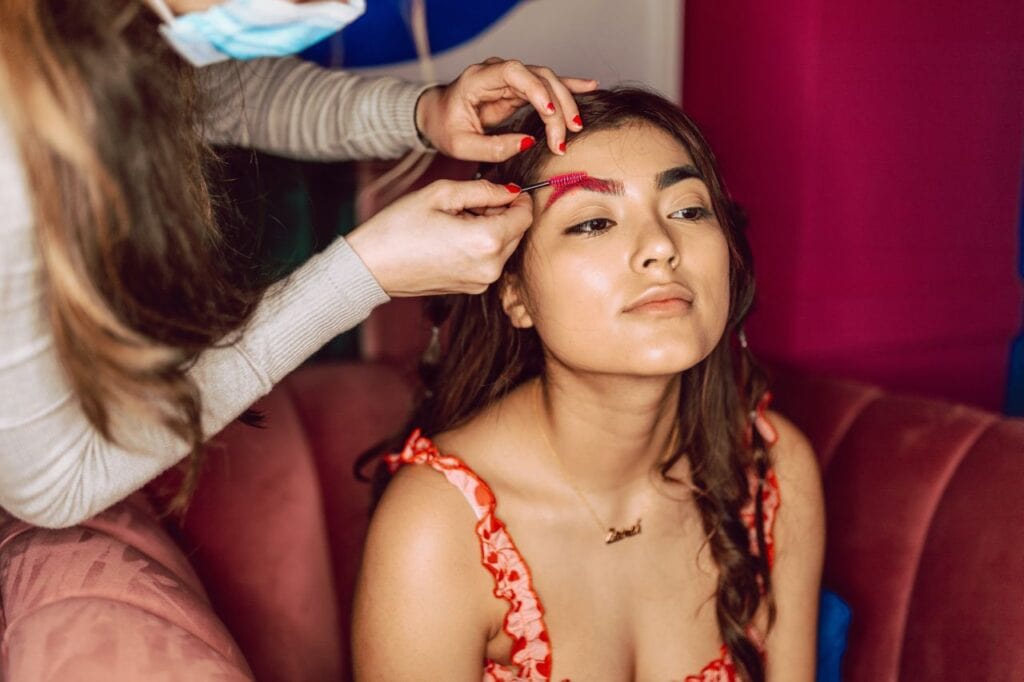Tattoos and permanent makeup have both evolved, with the latter eventually giving rise to what is now commonly referred to as "semi-permanent makeup," which includes procedures like eyebrow tattooing, eyeliner tattooing, lip tattooing, and so on.
Tattoo ink is introduced into the skin using tattoo guns, which employ a rotating mechanical coil to inject the ink. Larger, heavier, and more effective needles are used since they are placed all at once into the skin. In this way, they can cause some skin irritation.
Permanent makeup, on the other hand, uses less invasive instruments on the skin to introduce ink. Unfortunately, facial skin is far more delicate and sensitive than other areas of the body, making it much more challenging to retain control during tattooing. This means the process must be carried out with utmost caution.Our exclusive range of eyebrow tattoo services will help you in eyebrow microblading, feathering or hair stroke eyebrow tattooing procedures.
Read on for a comparison of tattoo ink and permanent cosmetics ink that will clear up any confusion you may have had about the two.
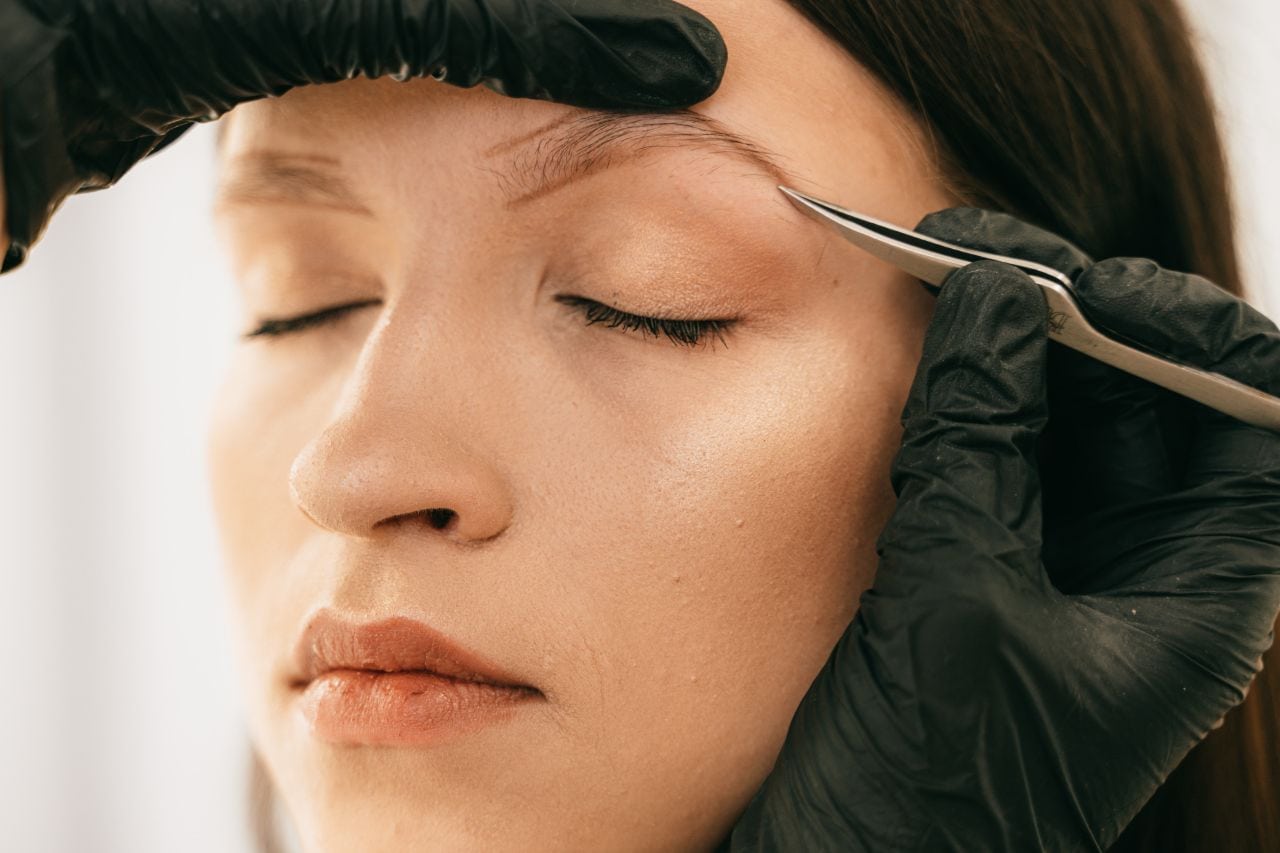
Ingredients & Ink
Ink is used to create tattoos, while pigments are used for permanent cosmetics. You might be wondering, "What is the difference?" Iron oxide, specifically, is used as the safest pigment in permanent cosmetics. However, a wide variety of chemicals, including mercury sulphide, lead, ash, chromium, nickel, iron oxide, and many more, are used in applying tattoos. Because of this, iron oxide pigment reduces the already low risk of an allergic reaction to tattoo ink. We'd also want to mention that tattoo ink is much runnier than the pigment used in permanent cosmetics.
Permanent makeup is done using pigments, while tattooing involves injecting ink into the skin. Permanent cosmetics include pigments in black, brown, and pink to redden the lips, while tattoo ink comes in a rainbow of hues. Tattoo embroidery, which uses a plant-based pigment implanted underneath the skin's epidermal layer to achieve the role of alteration and attractiveness, has limited endurance since the pigment's microscopic particles are metabolised quickly.
The Technique
The idea that permanent or semi-permanent makeup is nothing more than a tattoo on the face is widespread. The two methods are dissimilar. For a moment, we like to discuss human anatomy. Makeup is applied to the epidermis, the skin's outermost layer; the dermis, which is composed of sweat glands and connective tissue, hair follicles; and the hypodermis, which is composed of both connective tissue and fat.
In contrast to tattoo ink, permanent cosmetics pigments are injected into the outer layer of skin (the epidermis). The rationale is as follows:
1)Tattooing is much more painful, and
2)Unlike permanent cosmetics, which must be removed at some point, tattoos last a lifetime (though they may fade over time).
Microblading can last up to two years, permanent eyeliner for roughly a year before it needs to be touched up, and permanent lip blush for up to five years.
The Equipment
Different tools are needed for tattooing and permanent makeup; coil tattoo machines are the most frequent, but motor tattoo machines and wireless tattoo pens are also available. Traditional tattoo needles are made of multiple needles, while one-piece needles only have one. The most used needle sizes for tattooing are 0.30mm and 0.35mm.
Permanent makeup artists employ specialised equipment such as embroidery tattoo pens, eyebrow tattooing machines, and specific needles to apply for their work. Rotary machines are used nearly exclusively when applying permanent cosmetics due to their finer needles and greater precision. Permanent cosmetic needles, often between 0.20mm and 0.28mm, are more delicate and require gentler handling.
Healing & Durability
Since microblading eyebrows and permanent eyeliner are less intrusive than tattoos and the pigment is not injected as deeply into the skin, the healing time is significantly less (approximately ten days) than it is for tattoos (2-3 weeks). In any case, it's crucial to document any adverse reactions, such as swelling, rashes, or redness.
Permanent cosmetics pigments are not the same as tattoo inks because they are meant to fade gradually over time; nonetheless, the quality of your use will make a difference in the final result. Since the pigment is implanted into the skin only a third as deeply as in a conventional tattoo, the result is a considerably more subtle shade.
The shade and brand utilised can play a role in how long the effect lasts. Although most dyes fade after three to five years, others may remain vibrant for up to ten. To keep up the quality of work, it's a good idea to get touch-ups on a regular basis.
FAQs About Permanent Makeup And Tattoo
The typical method of getting a tattoo involves inserting needles into the skin, which creates a vacuum that forces the pigment to go deeper into the skin. In the case of a cosmetic tattoo, the colouring process involves a rotating motor that twists and slices the skin. This is done to apply the colour.
Microblading is a popular new method for putting artificial eyebrow hairs onto the skin, giving the appearance of a fuller, more natural brow.
Microblading is distinct from permanent makeup in several key respects, the most obvious being that each hairlike stroke of the line must be done by hand. In addition, the ink used for permanent cosmetics is much greater than that used for microblading.
The Food, Drug, and Cosmetic Act classifies the inks used in intradermal tattoos, including permanent makeup, as cosmetics. This includes the inks that are used in permanent makeup. This is the case regardless of whether or not they are put on the skin directly.
Yes. The colour of your permanent makeup will fade once a certain amount of time has passed. For example, most tattoos will start to fade in less than six months, but it can take anywhere from two to three years for them to remove entirely from the skin.
Microblading may feel different from getting a traditional tattoo and may cause less discomfort than getting a tattoo because of the anaesthetic cream applied to the skin before the procedure. In addition, the number of needles used in the procedure has been reduced. Getting a traditional tattoo typically does not need the use of any anaesthetic.
Purpose
The primary purpose of these two common methods is opposite to the other, and that's before you even consider the colour. People generally understand that tattoos are more colourful and daring, can be placed practically anywhere on the body, and are adaptable. Permanent makeup, on the other hand, is much gentler. Since the eyes, lips, and brows are where makeup is most often applied, this is a major perk. Busy professionals who don't have time to constantly apply makeup, persons with shaky hands and vision, and those with medical conditions including hair loss, discoloured lips, and others are common users of permanent makeup.
Many people may need help to hear a detailed explanation of the distinctions between tattoo ink and permanent makeup. However, it would be best if you made an educated choice about what you put into or on your body. Therefore, it's important to have all the facts before making any purchases. In addition, it's important to research before committing to any procedure, whether it's permanent makeup, tattooing, or something else.
Remember that getting a tattoo or using permanent cosmetics comes with its potential dangers and side effects, such as allergic responses to the tattoo ink or pigment, blistering, scarring, granulomas, and other skin conditions. In addition, the client's skin type, the quality of the professional use, and the care taken afterwards are all factors to consider.Want to know more about our eyebrow feathering services?
Vibrance Of Colour On The Skin
Compared to tattoo inks, the pigments used in permanent cosmetics are designed to fade away, gradually making them unique. The pigments are put into the skin about a third as deep as a regular tattoo. Due to this, the colour is much duller than before. Microscopic pigment particles suspended in a diluter make up cosmetic tattoo pigments.
Traditional tattoo inks are typically far more concentrated, resulting in a visibly more brilliant colour. In addition, the skin takes on a more realistic tone and sheen thanks to the increased saturation, which may be built up for an even more natural finish.
Machines & Penetration
There is a wide variety of tools used to apply tattoos and permanent cosmetics. Typically, a rotating machine is used to apply permanent makeup. A coil machine, as opposed to a rotary machine, is typically used to apply tattoos. The needle on these rotary devices is thinner and more delicate.
Unlike temporary cosmetic procedures, tattoos last a lifetime because their ink penetrates the hypodermis, the skin's deepest layer. Despite the name, permanent cosmetics only last up to 5 years because they only penetrate the dermis.
Components
Permanent cosmetics links are generated in the laboratory by combining carbon with a variety of additional elements, the most common of which are hydrogen, nitrogen, and oxygen. This allows for the creation of all the currently available colours. By adjusting the ratios, a wide range of hues is achievable. Natural mineral alumina hydroxide is another common ingredient in organic pigments for permanent makeup.
The most common colour for tattoo ink is black. Black ink is made from iron oxide, charcoal, and logwood. Combustion yields the raw elements for producing the black pigment known as soot, which includes magnetite crystals, wustite, powdered jet, amorphous carbon, and bone char.
The Permanent Results
Permanent Makeup
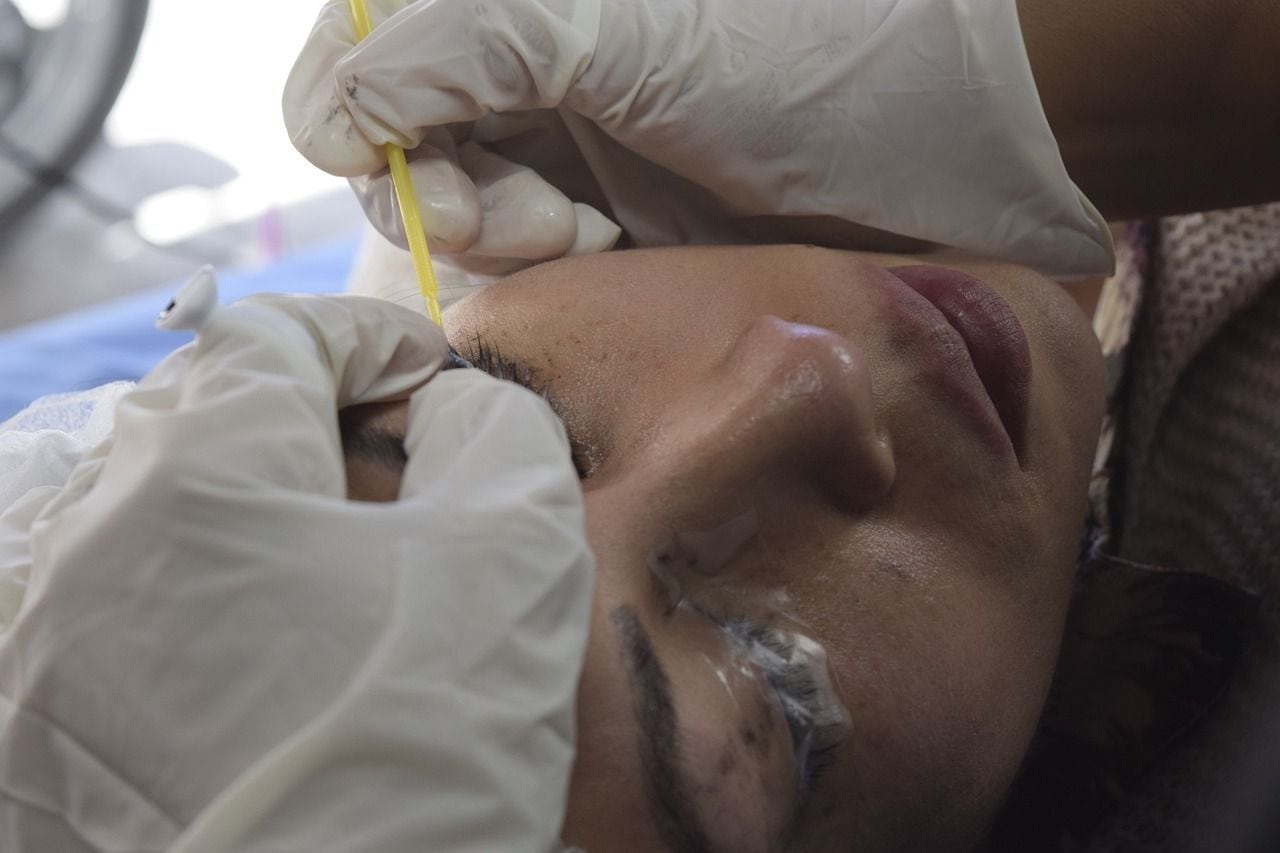
Permanent cosmetics pigments differ from tattoo inks in that they are designed to disappear over time rather than all at once. Looking for microblading salon? Look no further, Cosmetic Tattoo by Rach got you covered .
However, the outcome will vary depending on the grade of the pigments you employ. Since the pigment is only implanted about a third as deeply as in a conventional tattoo, the resulting colour is much more muted.
The length differs from one individual to the next and from one shade and brand to the next. Most colours fade after three to five years; however, others can hold their vibrancy for up to ten. It is highly recommended that regular retouching be done to preserve the intended appearance.
Tattoo Ink
Tattoo ink is highly developed, making it difficult to wash clean and requiring you to repeat the cleaning process repeatedly. In addition, getting a tattoo is unlike anything other, and even with today's laser tattoo removal technology, it can't be undone.
This is because tattoos use a unique hue, and the pigment particles tend to be very big. This means they won't be metabolised quickly, extending the life of the dye in your locks.
Conclusion
Pigments are used in permanent makeup, while the ink is utilised for tattoos. Permanent makeup uses less invasive equipment to introduce ink to the skin than tattoo guns, which inject ink into the skin. Regrettably, the skin of the face is far more sensitive and delicate than the skin on other parts of the body. Tattooing requires different implements than permanent makeup, including injecting colours into the epidermis. After healing, a lot less intensity is shown because the pigment is placed only a third as deeply as in a regular tattoo.
There are a couple of varieties of tattoo ink, the most well-known being traditional and long-lasting. Pigment for the tattoo is only implanted roughly a third as deeply as in a traditional tattoo. Permanent makeup uses fade-away pigments to create a one-of-a-kind look over time. You can use tattoo ink for both temporary and permanent body modifications. Tattoo ink has a higher pigment load, producing a more vivid hue and a more natural shine.
Carbon is combined with many other elements in the lab to produce organic pigments, which are then used to create permanent cosmetics. Colours used in permanent makeup are meant to fade gradually rather than all at once. The colour is less intense since the pigment is placed roughly a third as deeply as in a regular tattoo. While most colours lose their vibrancy after three to five years, some can keep theirs for as long as 10.
Content Summary
- Permanent makeup, on the other hand, uses less invasive instruments on the skin to introduce ink.
- Ink is used to create tattoos, while pigments are used for permanent cosmetics.
- Permanent makeup uses pigments, while tattooing involves injecting ink into the skin.
- The idea that permanent or semi-permanent makeup is nothing more than a tattoo on the face is widespread.
- In contrast to tattoo ink, permanent cosmetics pigments are injected into the outer layer of skin (the epidermis).
- The rationale is as follows:1) Tattooing is much more painful, and 2) Unlike permanent cosmetics, which must be removed at some point, tattoos last a lifetime (though they may fade over time). Microblading can last up to two years, permanent eyeliner for roughly a year before it needs to be touched up, and permanent lip blush for up to five years.
- Different tools are needed for tattooing and permanent makeup; coil tattoo machines are the most frequent, but motor tattoo machines and wireless tattoo pens are also available.
- The most used needle sizes for tattooing are 0.30mm and 0.35mm.
- Permanent makeup artists employ specialised equipment such as embroidery tattoo pens, eyebrow tattooing machines, and specific needles to apply for their work.
- Since microblading eyebrows and permanent eyeliner are less intrusive than tattoos and the pigment is not injected as deeply into the skin, the healing time is significantly less (approximately ten days) than it is for tattoos (2-3 weeks).
- Permanent cosmetics pigments are not the same as tattoo inks because they are meant to fade gradually over time; nonetheless, the quality of your use will make a difference in the final result.
- To keep up the quality of work, it's a good idea to get touch-ups regularly.
- Many people may need help to hear a detailed explanation of the distinctions between tattoo ink and permanent makeup.
- However, it would be best if you made an educated choice about what you put into or on your body.
- In addition, it's important to research before committing to any procedure, whether it's permanent makeup, tattooing, or something else.
- Remember that getting a tattoo or using permanent cosmetics has potential dangers and side effects, such as allergic responses to the tattoo ink or pigment, blistering, scarring, granulomas, and other skin conditions.
- In addition, the client's skin type, the quality of the professional use, and the care taken afterwards are all factors to consider.
- Microscopic pigment particles suspended in a diluter make up cosmetic tattoo pigments.
- There is a wide variety of tools used to apply tattoos and permanent cosmetics.
- Typically, a rotating machine is used to apply permanent makeup.
- Natural mineral alumina hydroxide is another common ingredient in organic pigments for permanent makeup.
- The most common colour for tattoo ink is black.
- Permanent cosmetics pigments differ from tattoo inks in that they are designed to disappear over time rather than all at once.
- However, the outcome will vary depending on the grade of the pigments you employ.
- Since the pigment is only implanted about a third as deeply as in a conventional tattoo, the resulting colour is much more muted.
- In addition, getting a tattoo is unlike anything other, and even with today's laser tattoo removal technology, it can't be undone.
- This is because tattoos use a unique hue, and the pigment particles tend to be very big.
- This means they won't be metabolised quickly, extending the life of the dye in your locks.
